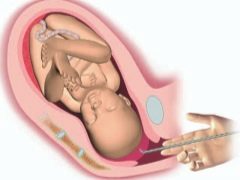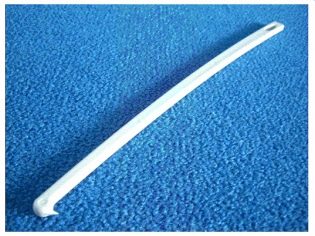What is amniotomy in childbirth and why do the bubble puncture?
During childbirth or before they begin, doctors can make a woman an amniotomy. It is believed that it has a beneficial effect on the speed of the generic process, and in some cases is considered a necessary measure. In this material, we consider what kind of manipulation it is and what it can be used for in childbirth.
Some theory
During the period of intrauterine development, the child is perfectly protected - it is protected not only by the anterior abdominal wall of the mother, but also by the fetal bladder, which is a strong multi-layer “bag”, inside which the child is surrounded by the amniotic fluid.
The inner shell of the bubble is called the amnion, it is she who participates in the synthesis and renewal of amniotic fluid. The environment inside the fetal bladder is sterile, it protects the baby from contact with bacteria, viruses, fungal flora and other undesirable agents and organisms.
Water baby swallows, so that they are involved in the formation of the digestive system, in addition, amniotic fluid - an excellent natural shock absorber.
In natural childbirth, the bubble opens itself. This usually occurs even when active intense contractions are taking place and cervical dilatation is approaching 5-6 centimeters. A shrinking reproductive organ leads to an increase in intrauterine pressure; the neck, when opened during contractions, releases a special enzyme that thinns the fetal bladder.
The kid himself complements the mechanism, which presses the head on its lower part, as a result, the shells break, water leaves its place, goes outside.
Sometimes childbirth begins with a rupture of the shells, and not with contractions. And then doctors imply childbirth, complicated by premature outpouring of water. Sometimes the walls of the bubble are so strong that even with the beginning of attempts, they are not broken. This is a variant of the norm, doctors can leave it (if the baby is born prematurely) or be punctured by hand.
It is a manual or instrumental violation of the integrity of the sac of the sac and is called amniotomy. In labor, this uncomplicated and painless manipulation can play a crucial role. The birth canal and cervix receive a large amount of enzymes that go out with the waters and stimulate the cervix to a more active opening. This measure shortens the time of delivery by about a third in most cases.
If a woman has a placenta and bleeding is present, amniotomy helps stop it. In women suffering from high blood pressure, the pressure after a puncture of the bladder is reduced, which allows doctors to facilitate the course of labor and the condition of the woman in labor.
Amniotomy is not performed for women who have a planned cesarean section.
With all the advantages of amniotomy, it is not recommended to do it without certain medical indications established by clinical guidelines for this manipulation.
Indications
Speaking of clinical recommendations, it should be noted that the puncture of the bladder is strongly recommended for pregnant women who do not begin to give birth even after the date of expected birth has long been left behind. Usually, experts begin to seriously think about such a manipulation when the 42th week of gestation takes place, but there is no generic activity. Then the induction of labor begins exactly with amniotomy.
After a puncture, the birth canal of the uterus usually begins within 2-5 hours, the cervix is naturally stimulated to open.The generic process due to this becomes shorter, and after about 10-12 hours or a little more, you can count on the appearance of the child at the first birth, and after 8-9 hours at the second and subsequent.
When the process is already underway, a puncture may be necessary in such situations.
- The contractions are transient, the cervix is opened up to 8 centimeters or more, the sac of sac remains intact. If these genera are not premature, then there is no point in preserving it.
- The woman has weak contractions, the neck opening is poor, the contractions are weak or have ceased, primary birth weakness is recorded.
- The woman was diagnosed with high water during pregnancy.
- Diagnosed oligohydramnios (so-called flat bladder).
- Natural childbirth in multiple pregnancies. This applies only to twins, which have separate fetal bubbles. When identical twins amniotomy try to avoid. Open the fetal bladder of the second child from twins 10 minutes after the birth of the first baby.
The recommendations urge doctors to be vigilant and not to allow early amniotomy. Early puncture is called, which is done when the cervix is not ready for childbirth, there are no signs of the beginning of disclosure. An immature neck is not stimulated by enzymes from the amniotic fluid, and therefore various complications may develop.
Among them - the development of primary generic weakness, fetal hypoxia, a long anhydrous period. In the end, it will all end with a cesarean section on an emergency basis. A long anhydrous period before the operation will increase the likelihood of endometriosis and other inflammatory processes in the postpartum period by tens of times.
When not pierced?
Amniotomy deprives the child of protection in the form of amniotic fluid, and therefore the probability of infection of the uterus and the baby while it is without water is high. In connection with this risk, the puncture of the bladder is not carried out if a woman has an aggravation of genital herpes or another disease of the genital tract, if there is vaginosis, a smear analysis on the microflora revealed a violation of the flora.
There is no feasibility in the puncture of the fetal sac and with the wrong presentation of the fetus - pelvic, oblique or transverse. The procedure for labor induction is not carried out with placenta previa, as well as when touching the exit from the uterus of the umbilical cord loop.
Narrow pelvis, triplets in my mother's womb, pregnancy after IVF, suspicion of hypoxia of the baby, rhesus conflict between the mother and the child are all grounds for refusing amniotomy and indications for caesarean section.
How is it done?
In what way to open the fetal bladder, the obstetrician or doctor decides on the situation. It is possible to pierce, tear, cut or tear it manually without the use of tools. If the cervix is weakly opened, it is usually preferred to pierce the membranes, if the opening is sufficient to let the obstetrician’s fingers pass, then it will be torn manually.
Often women are interested in whether it hurts to pierce the bladder. The answer is absolutely unequivocal - it does not hurt, since there is not a single nerve ending and pain receptor in the fetal membranes. Pain, respectively, a woman can not even theoretically.
The procedure is carried out quickly, almost at lightning speed, but requires some preparation. It consists in taking the drug antispasmodic action about half an hour before the proposed amniotomy, to relax the muscles of the cervix. Usually, “No-Shpu” is used in pills or an injection is given with a solution of this drug.
The procedure does not belong to the category of surgery, and therefore it can be performed not only by a doctor, but also by an obstetrician. The sensations of a woman are not much different from the sensations in a normal gynecological examination in the chair. A medical professional wears sterile gloves. The fingers of one hand are inserted into the vagina, with the other hand a special branch is inserted - a long thin stick with a small hook at the end.With a small opening of the cervix, the fetal membrane is hooked up and stretches towards itself.
A doctor or an obstetrician slightly widens the tear with his fingers in a sterile glove and makes sure that the waters flow away smoothly, unsharply, because their massive discharge can cause the part of the baby’s body, the umbilical cord, to fall out in the genital tract, which will significantly complicate childbirth or emergency caesarean section.
The woman is lying for at least half an hour; cardiotocograph sensors are installed on her tummy in order to monitor the condition of the baby in real time, which unexpectedly remains without its habitat.
At any stage of labor, a bubble can be punctured or ruptured according to indications. For the beginning of labor - in front of them, to enhance contractions - during the first stage, to prevent bleeding during the baby’s passage through the birth canal, the bubble can be opened already during the period of attempts.
In preterm labor, it is considered desirable to preserve the integrity of the fetal bladder, if it does not break. So the baby, who hurried to be born, will be easier to adapt. Children born with intact membranes are usually said to be "born in a shirt." The people have always believed that this is the way higher powers mark rare lucky ones, which will be promoted by incredible luck throughout their life journey.
Consequences and complications
Problems after the bubble has been punctured occur infrequently, but still, by signing informed consent to such an intervention, the woman automatically agrees that she is familiar with the list of possible consequences. And they can be different - from the development of weak contractions to infection. If primary generic weakness develops, start stimulating with hormonal drugs. If after this for a couple of hours the contractions do not begin, they prefer operational delivery.
Amniotomy is not considered natural, for the female body it is a stress, and therefore the consequences can be very significant:
- develop fast, rapid delivery;
- omission of the umbilical cord, handles, or legs of the fetus into the genital tract;
- damage to the blood vessel, if it is located on the surface of the bladder, and subsequent bleeding;
- development of a state of acute oxygen deficiency in the baby;
- probability of infection in the uterus.
In order to avoid infection and damage to blood vessels, physicians pay sufficient attention to sanitary and hygienic requirements, use disposable sterile gloves and tools. But no preventive measures can guarantee that the uterus begins to contract, and the cervix to open, and therefore a puncture is always a certain risk.
Reviews
Despite the fact that the Ministry of Health prescribes doctors to notify the woman about all the details of the upcoming procedure and the risks associated with it, doctors, in the opinion of women, often carry out a puncture on the situation, and only then they say that the puncture took place. On the one hand, sudden manipulation has its advantages - a woman does not have time to get scared. On the other hand, the lack of complete information violates the rights of the patient.
For more information about the indications for amniotomy and its implementation, see the video below.





















